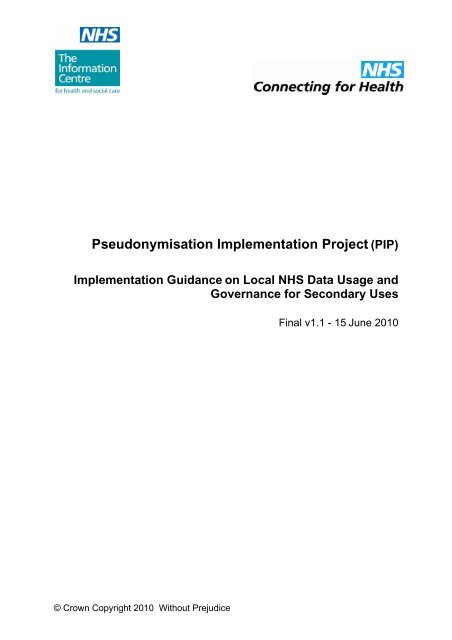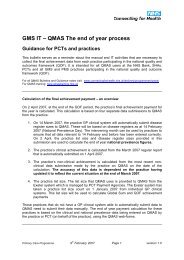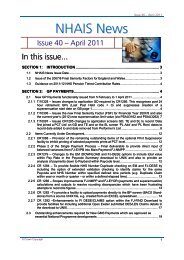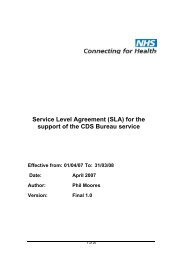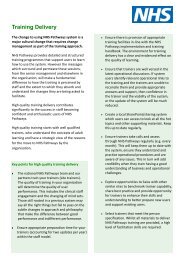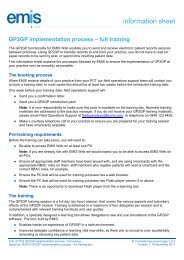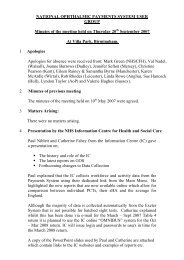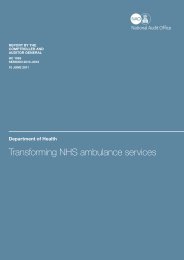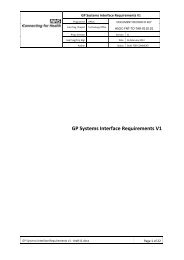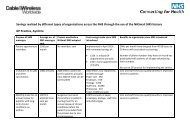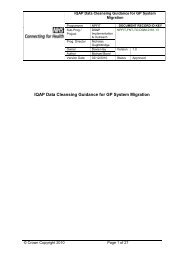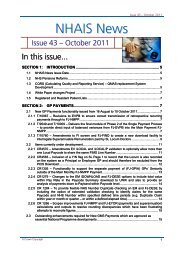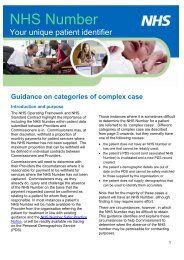Pseudonymisation Implementation Project - NHS Connecting for ...
Pseudonymisation Implementation Project - NHS Connecting for ...
Pseudonymisation Implementation Project - NHS Connecting for ...
You also want an ePaper? Increase the reach of your titles
YUMPU automatically turns print PDFs into web optimized ePapers that Google loves.
<strong>Pseudonymisation</strong> <strong>Implementation</strong> <strong>Project</strong> (PIP)<strong>Implementation</strong> Guidance on Local <strong>NHS</strong> Data Usage andGovernance <strong>for</strong> Secondary UsesFinal v1.1 - 15 June 2010© Crown Copyright 2010 Without Prejudice
Header textPIP <strong>Implementation</strong> GuidanceProgramme NPFIT Document Record ID KeySub-Prog / <strong>Pseudonymisation</strong> <strong>Implementation</strong><strong>Project</strong> <strong>Project</strong> (PIP)NPFIT-FNT-TO-BPR-0022.01Prog.DirectorJ Thorp Version 1.1Owner . Status FinalAuthor Wally Gowing Version Date 15 June 2010Document Status:This is a controlled document.Whilst this document may be printed, the electronic version maintained in FileCM isthe controlled copy. Any printed copies of the document are not controlled.Related Documents:These documents will provide additional in<strong>for</strong>mation.Ref Doc Reference Number Title VersionNPFIT-FNT-TO-BPR-0022.01 PIP <strong>Implementation</strong> Guidance FV1.11 NPFIT-FNT-TO-BPR-0023.01 Reference Paper 1 - Terminology 1 FV1.12 NPFIT-FNT-TO-BPR-0024.01 Reference Paper 2 – Business Processes and FV1.1Safe Havens 23 NPFIT-FNT-TO-BPR-0025.01 Reference Paper 3 – De-identification 3 FV1.14 TBA Reference Paper 4 – Technical White Paper 4 FV2.15 dh_4069254 <strong>NHS</strong> Code of Practice on Confidentiality 56 NA PIP Planning Template and Guidance 61http://www.connecting<strong>for</strong>health.nhs.uk/systemsandservices/sus/delivery/pseudo2http://www.connecting<strong>for</strong>health.nhs.uk/systemsandservices/sus/delivery/pseudo3http://www.connecting<strong>for</strong>health.nhs.uk/systemsandservices/sus/delivery/pseudo4http://www.connecting<strong>for</strong>health.nhs.uk/systemsandservices/sus/delivery/pseudo5 5www.dh.gov.uk/en/Managingyourorganisation/In<strong>for</strong>mationpolicy/Patientconfidentialityandcaldicottguardians/DH_41005506 http://www.connecting<strong>for</strong>health.nhs.uk/systemsandservices/sus/delivery/pseudoFinal v1.1 15 June 2010© Crown Copyright 2010Page 2 of 21
Header textContents1 Introduction .............................................................................................. 41.1 Purpose and scope ........................................................................ 41.2 PIP Aims and <strong>Implementation</strong> ........................................................ 41.3 Related papers .............................................................................. 51.4 Who should read this paper? ......................................................... 61.5 How to use this guidance ............................................................... 71.6 Patient label ................................................................................... 71.7 Applying the Guidance ................................................................... 72 Secondary Uses and Risk Mitigation ..................................................... 82.1 Secondary Uses ............................................................................ 82.2 Risk Mitigation and implementing de-identification ........................ 82.3 Local <strong>Implementation</strong> ..................................................................... 93 Context <strong>for</strong> implementing Local Data Usage and Governance .......... 103.1 In<strong>for</strong>mation Governance Context ................................................. 103.2 <strong>NHS</strong> Business Needs .................................................................. 103.3 Secure environment ..................................................................... 113.4 Outside the Secure environment ................................................. 113.5 Organisations covered ................................................................. 113.6 Exceptions ................................................................................... 124 <strong>Implementation</strong> Guidance Framework ................................................. 134.1 <strong>Implementation</strong> Guidance development ...................................... 134.2 <strong>Implementation</strong> Guidance rationale ............................................. 134.3 <strong>Implementation</strong> Guidance – out of scope .................................... 144.4 Relating <strong>Implementation</strong> Steps to Guidance ................................ 154.5 Specific Issues arising from the Guidance ................................... 155 How to proceed ...................................................................................... 185.1 Overview ...................................................................................... 185.2 Strategic Issues ........................................................................... 185.3 <strong>Implementation</strong> Actions ................................................................ 19Final v1.1 15 June 2010© Crown Copyright 2010Page 3 of 21
PIP <strong>Implementation</strong> Guidance<strong>Pseudonymisation</strong> <strong>Implementation</strong> <strong>Project</strong> <strong>Implementation</strong>Guidance1 Introduction1.1 Purpose and scopeThis paper provides an updated set of local implementation guidance <strong>for</strong> the <strong>Pseudonymisation</strong><strong>Implementation</strong> <strong>Project</strong> (PIP) and links to other PIP documents that provide reference material,guidance and general in<strong>for</strong>mation.The purpose of this paper is to:■■■■■Provide a pathway through the steps that need to be taken to implement localdata usage and governance from the viewpoint of different organisationsinvolved in running <strong>NHS</strong> business operations.Provide high-level guidance on governance arrangements to ensure that‘effective anonymisation’ can be achieved to mitigate risk associated with use ofpatient data.Provide high-level guidance on governance arrangements and technicalsolutions <strong>for</strong> de-identification, which will ensure the security and confidentiality ofperson level data within local systems, referred to within PIP as implementinglocal data usage and governance.Provide links to the separate elements of more specific guidance coveringterminology, safe havens and business processes, de-identification and security.The scope of the document is there<strong>for</strong>e concerned with the management anduse of patient identifiable in relation to <strong>NHS</strong> business operations; it is notconcerned with the use of such data <strong>for</strong> medical research purposes.This paper has been updated to reflect developments in relation to the In<strong>for</strong>mation Governancetoolkit, standards etc as well further work in particular areas, such as invoices and social care.1.2 PIP Aims and <strong>Implementation</strong>The overall aims of the PIP are to enable:■■■The legal and secure use of patient data <strong>for</strong> secondary purposes by the <strong>NHS</strong>(and other organisations involved in the commissioning and provision of <strong>NHS</strong>commissionedcare)<strong>NHS</strong> business to no longer use identifiable data in its non-direct care relatedwork wherever possible<strong>NHS</strong> business processes to continue to be effective in supporting the day to dayoperation of the <strong>NHS</strong>.The target aim of the project is that <strong>NHS</strong> businesses complete this transition by April 2011.Initial work of the <strong>Project</strong> included a questionnaire sent to all affected organisations. Thisprovided valuable in<strong>for</strong>mation on flows of patient data <strong>for</strong> secondary use purposes andidentified practical issues to be addressed in implementation.<strong>NHS</strong> organisations were required through the 2009/10 Operating Framework In<strong>for</strong>maticsPlanning Guidance to submit plans <strong>for</strong> implementation of pseudonymisation. A planningtemplate and guidance (Ref 6) were provided to support development of high level plans by<strong>NHS</strong> organisations. The template and associated maturity model identified 14 key steps orFinal v1.1 15 June 2010© Crown Copyright 2010Page 4 of 21
PIP <strong>Implementation</strong> Guidancerequirements to be met as part of delivering local solutions and required completion and returnto their relevant SHA and to PIP. The documents acted as a mechanism <strong>for</strong> generating highlevelplans and raising organisational awareness of the need <strong>for</strong> de-identification of data used<strong>for</strong> secondary purposes.In order to assess the starting point <strong>for</strong> each organisation and to be able to track progress, aMaturity Model was developed covering the 12 essential implementation steps. The planningtemplate also gathered in<strong>for</strong>mation on perceived issues and problems, which together with thebaseline scores from the Maturity Model have been taken into account in preparing thisguidance.The aims of PIP are embedded in version 8 of the In<strong>for</strong>mation Governance Toolkit (IGT). IGT8has a requirement that ‘the organisation protects the confidentiality of service user in<strong>for</strong>mationthrough use of pseudonymisation and anonymisation techniques where appropriate”.There are two consequences of the IGT requirement. These are:■■IGT8 refers to “Safe Haven” rather than “New Safe Haven 7 ” as the de-identification needs<strong>for</strong> secondary use should build on the existing safe haven mechanisms already in use in<strong>NHS</strong> organisations. There<strong>for</strong>e the IGT8 expression is used throughout this andassociated papers; in some instances the expression “local Safe Haven” is used toemphasise the local nature of the purpose of the safe haven;The attainment levels <strong>for</strong> this IGT requirement follow the structure of the IGT and do notuse the PIP Maturity Model. The Maturity Model has similar requirements, such as‘documented plan’, and can be used to measure local progress.The need to de-identify patient data to protect service user confidentiality is reflected in theStandards Framework <strong>for</strong> De-identification of <strong>NHS</strong> and Social Care Data, approved in principleat the In<strong>for</strong>mation Standards Board meeting of April 2010. The Standards Framework will bepublished in the near future, together with a relevant In<strong>for</strong>mation Standards Notice (ISN).This paper provides the guidance referred to in the Planning Guidance on the implementationof data usage and governance <strong>for</strong> secondary uses. The paper is provided in order thatorganisations can better understand the detailed requirements and <strong>for</strong> development of theirdetailed plans in order to meet the IGT8 requirement.1.3 Related papersThis guidance builds on the earlier PIP documents■■PIP <strong>Implementation</strong> Planning GuidancePIP Maturity ModelThe guidance is based upon a set of reference documents:■ Reference Document 1 – PIP Terminology, (Ref 1)■ Reference Document 2 – Business Processes and Safe Havens, (Ref 2)■ Reference Document 3 – De-identification, (Ref 3)■ Reference Document 4 – Techniques, (Ref 4)These reference documents have been written as standalone documents to provide coherentguidance in their own right in order to meet the needs of different audiences. It followsthere<strong>for</strong>e that there is a limited duplication of content across the papers. Please note thatReference Document 2 has been modified <strong>for</strong> consistency with IGT8.7A term used during early stages of PIP work and in previous versions of this and other related guidanceFinal v1.1 15 June 2010© Crown Copyright 2010Page 5 of 21
PIP <strong>Implementation</strong> GuidanceMuch work has been already undertaken on in<strong>for</strong>mation security across <strong>NHS</strong> and PIP has astated aim to build on that work. There<strong>for</strong>e, a separate paper on security has not beenproduced. Many aspects of security good practice are cited within the reference documents;and CFH publish Good Practice Guidance on relevant subjects, such as cryptographicalgorithms and password management.1.4 Who should read this paper?The PIP <strong>Implementation</strong> Planning Guidance indicated that PIP applies to:■■■■■■All commissioners - responsible <strong>for</strong> their own data usage activities and that theresponsibilities of providers are reflected in contractsAll providers - including Independent Sector Treatment Centres/Providers(ISTC/P) and third sector providersAll shared services operating services that process patient level data <strong>for</strong>secondary use purposesAmbulance servicesPublic Health Observatories (PHO) - <strong>for</strong> those uses of patient data not coveredby Section 60/251 regulations <strong>for</strong> Public Health.SHAs – to ensure that appropriate data usage takes place in all organisations inthe SHA’s area (i.e. assurance, capacity, capability); to ensure con<strong>for</strong>mance byany ‘hosted services’ <strong>for</strong> which they are responsible and may have identifiablepatient data used <strong>for</strong> secondary purposes; to ensure con<strong>for</strong>mance where theSHA may be a major stakeholder or participant in projects analysing data tosupport per<strong>for</strong>mance management and system re<strong>for</strong>m.The focus of the papers is on <strong>NHS</strong> commissioners and providers of services <strong>for</strong> <strong>NHS</strong>commissioned care. Where specific organisation type guidance <strong>for</strong> commissioners andproviders appears in the guidance documents, then:■■■PHOs should follow the guidance <strong>for</strong> commissioners;Ambulance services and ISTC/Ps should follow the guidance <strong>for</strong> providersShared Services should follow the guidance relevant to the types o<strong>for</strong>ganisations to which they are providing services.This paper and the others referenced above are aimed at the staff responsible <strong>for</strong> implementingde-identification and good practice in local data usage of patient data <strong>for</strong> non-direct carepurposes.These papers are there<strong>for</strong>e intended to provide in<strong>for</strong>mation <strong>for</strong> a range of staff including:■■■■■In<strong>for</strong>matics directors and managers with responsibility <strong>for</strong> implementing localdata usage and governance<strong>Project</strong> managers with responsibility <strong>for</strong> managing the resulting implementationprojectIG staff <strong>for</strong> understanding the IG implications of de-identification of patient datawhen used <strong>for</strong> non-direct care purposesManagers responsible <strong>for</strong> business processes currently using patient identifieddata <strong>for</strong> non-direct care purposes and needing to make changesICT management and staff <strong>for</strong> assessing the impact on systems and determiningthe means of and undertaking the implementation of the technical solutions.Final v1.1 15 June 2010© Crown Copyright 2010Page 6 of 21
PIP <strong>Implementation</strong> Guidance■These papers are not intended <strong>for</strong> Chief Executives; the papers may be useful<strong>for</strong> Caldicott Guardians and Senior In<strong>for</strong>mation Risk Owners if they need toreference material in relation to secondary uses.1.5 How to use this guidanceThis guidance and its supporting documentation can be related directly to the essentialimplementation steps used in the original Planning Guidance and Maturity Model as illustratedin Figure 1. Further in<strong>for</strong>mation is given in Section 5 on accessing guidance <strong>for</strong> specificorganisations.Figure 1 Guidance and <strong>Implementation</strong> Steps<strong>Implementation</strong> StepMainGuidanceSafe Haven &Business ProcessDeidentificationR7 Data Management √R8 <strong>Pseudonymisation</strong>Functionality√R9 Safe Haven √ √R10 Access Control √ √ √R11 User Registration √ √R12 End user applications √R13 Business process √√changeR14 Log & audit trails √White Paper onTechniques√1.6 Patient labelThroughout this and the related papers, the term ‘patient label’ is used to describe the dataitem(s) that distinguishes one patient from another in a set of data; please note that this ispurely <strong>for</strong> the purposes of clarity within the papers.For identifiable data, the patient label may be the <strong>NHS</strong> Number (if present) but could be withinan organisation, its Local Patient Identifier; another data item, or combination of data items,that can be used to uniquely identify one patient from another; in de-identified data sets, patientlabels will vary but, <strong>for</strong> example, can be pseudonyms or table row numbers (the latter may notbe unique as activity relating to the same patient may appear more than once in a table.)1.7 Applying the GuidanceThis document and its associated reference papers provide guidance on how to mitigate risk inorder to balance risks associated with patient data with being able to effectively operate <strong>NHS</strong>business processes. The guidance is based on principles and is necessarily generic andcannot take into account the myriad of organisational arrangements affecting access to patientdata, such as PAS facilities shared between multiple providers and commissioners. Theapplication of the guidance on a local basis needs to be undertaken with due regard to the localcircumstances.In the event of uncertainty or requiring help, please check with the SUS <strong>Pseudonymisation</strong>websites 8 (including the FAQs) or contact the local SHA IG or PIP Lead.8http://www.connecting<strong>for</strong>health.nhs.uk/systemsandservices/sus/delivery/pseudo orhttp://www.ic.nhs.uk/services/the-secondary-uses-service-sus/pseudonymisation-implementation-projectFinal v1.1 15 June 2010© Crown Copyright 2010Page 7 of 21
PIP <strong>Implementation</strong> Guidance2 Secondary Uses and Risk Mitigation2.1 Secondary UsesA high level definition of secondary uses is developed in the PIP Reference Paper 1 Guidanceon Terminology (Ref 1). Secondary uses equates to non-healthcare medical purposes usewithin medical purposes as set out in Confidentiality: the <strong>NHS</strong> Code of Practice (Ref 5). Ineffect, secondary use of patient data is the use <strong>for</strong> purposes that do not directly contribute tothe safe care of the individual concerned.Purposes that directly contribute to the safe care of the patient are classified as primary usesand include care, diagnosis, referral and treatment processes together with relevant supportingadministrative processes, such as clinical letters and patient administration, patientmanagement on a ward, managing appointments <strong>for</strong> car; as well as the audit/assurance of thequality of the healthcare provided.Confidentiality also clearly states that use of patient data <strong>for</strong> non-healthcare medical purposesmust be ‘effectively anonymised’, that is in de-identified <strong>for</strong>m unless it is with the patient’sconsent or otherwise covered in law, such as with approval under Section 251 of the 2006 <strong>NHS</strong>Act given by the National In<strong>for</strong>mation Governance Board (NIGB) Ethics and ConfidentialityCommittee (ECC).It is necessary to distinguish between the two types of use in order to determine what data auser can see. Examples of secondary use of patient data are per<strong>for</strong>mance management,commissioning, contract monitoring; all of which do not require the identity of patients. Thereare functions within the <strong>NHS</strong> that use the same data sources <strong>for</strong> both secondary and primaryuses. An example at PCT level would be <strong>for</strong> per<strong>for</strong>mance monitoring of Referral to Treatment(RTT) which should use de-identified data, but <strong>for</strong> organising care provision within 18 weeks,access to identifiable data is a primary use and there<strong>for</strong>e permissible by a suitably authorisedmember of staff.Practical examples of secondary uses are given in the PIP Reference Paper 2 on Safe Haven& Business Processes Guidance (Ref 2).2.2 Risk Mitigation and implementing de-identificationThe aims of PIP are concerned with mitigating risks, in particular those associated with the useof identifiable data, and ensuring that patient data is managed in legal and secure ways. It isvital that clinical risk is not introduced or increased by introducing de-identification; <strong>for</strong> examplefailure in accurately identifying patients needing follow-up action after analysis ofpseudonymised data, or inappropriately de-identifying data.The risk of identification of patients, either inadvertent or malicious, when the data is used <strong>for</strong>secondary purposes, such as per<strong>for</strong>ming <strong>NHS</strong> business processes, must be minimised. This isbecause the identity of patients is not usually pertinent to secondary uses and if identity ispertinent then relevant channels to gain access to identifiable data should be pursued.As indicated in Confidentiality it is necessary to achieve a suitable level of ‘effectiveanonymisation’ in the context of <strong>NHS</strong> business uses; this guidance sets out the stepsnecessary to reach such a level.The aim is there<strong>for</strong>e to minimise risk to an acceptable level in the context of <strong>NHS</strong> business, seeFigure 2; there are a variety of techniques to achieve this whilst balancing risk reductionagainst the utility of the data and its purposes.Achieving effective anonymisation requires actions to be taken on data handling andmanagement regimes, modification of business processes and implementation of deidentification.Final v1.1 15 June 2010© Crown Copyright 2010Page 8 of 21
PIP <strong>Implementation</strong> GuidanceDe-identification is the general term <strong>for</strong> any process of removing or reducing the associationbetween a set of identifying data and the data subject in order to protect personalconfidentiality. This can range from partial de-identification (where only some of the personidentifiers such as <strong>NHS</strong> number, date of birth, postcode are removed) to complete (where allperson identifiers are removed) and a range in between.It is important that the steps taken to mitigate the risks associated with the use of patient data<strong>for</strong> non-direct care purposes are recorded, whether they are <strong>for</strong> the full implementation of deidentificationas set out in the PIP documents or not. This is because of the changingexpectation on the use of identifiable data in this way and the potential <strong>for</strong> external reviewthrough the regulatory mechanisms.Figure 2 Risk Mitigation2.3 Local <strong>Implementation</strong>Local organisations must decide on their approach to implementation to achieve the deidentificationof person level data that is used <strong>for</strong> non-direct care purposes. These decisionswill necessarily be taken in the context of competing operational and financial priorities, andreflect the wider risk management responsibilities of these organisations.Each organisation that makes non-direct care use of patient data organises its businessprocesses, departments and systems to meet its own needs. There<strong>for</strong>e there is great variety inthe local context <strong>for</strong> the non-direct care use of patient data. The work undertaken by the PIPTeam has included attempting to gain an understanding of that variety in order to developgeneric solutions and guidance to enable de-identification and supporting measures to beimplemented.There are different ways to implement the steps necessary to enable the non-direct care use ofpatient data to be undertaken with de-identified data. The responsibility <strong>for</strong> achieving this aspart of an organisation’s In<strong>for</strong>mation Governance obligations rests with the management of theorganisation. The decisions on how to implement local data usage and governance using deidentificationare <strong>for</strong> each organisation to take.Please note that implementation of all processes <strong>for</strong> de-identifying, pseudonymising and reidentifyingpatients must be subject to adequate testing prior to live deployment in businessprocesses.Final v1.1 15 June 2010© Crown Copyright 2010Page 9 of 21
PIP <strong>Implementation</strong> Guidance3 Context <strong>for</strong> implementing Local Data Usage andGovernance3.1 In<strong>for</strong>mation Governance ContextThe Caldicott Principles as set out in Table 1 apply to uses of patient data, including those <strong>for</strong>secondary purposes and these principles <strong>for</strong>m a backdrop against which implementation oflocal data usage and governance takes place.Table 1 Caldicott PrinciplesPrinciple 1: Justify thepurpose(s)Principle 2: Do not use patientidentifiablein<strong>for</strong>mation unless itis absolutely necessaryPrinciple 3: Use the minimumnecessary patient-identifiablein<strong>for</strong>mationPrinciple 4: Access to patientidentifiablein<strong>for</strong>mation shouldbe on a strict need to knowbasisPrinciple 5: Everyone should beaware of their responsibilitiesPrinciple 6: Understand andcomply with the lawEvery proposed use or transfer of patient-identifiablein<strong>for</strong>mation within or from an organisation should be clearlydefined and scrutinised, with continuing uses regularlyreviewed by an appropriate guardian.Patient-identifiable in<strong>for</strong>mation items should not be usedunless there is no alternative.Where use of patient-identifiable in<strong>for</strong>mation is considered tobe essential, each individual item of in<strong>for</strong>mation in a data setshould be justified with the aim of reducing identifiability.Only those individuals who need access to patientidentifiablein<strong>for</strong>mation should have access to it, and theyshould only have access to the in<strong>for</strong>mation items that theyneed to see.Action should be taken to ensure that those handling patientidentifiablein<strong>for</strong>mation, clinical and non-clinical staff, areaware of their responsibilities and obligations to respectpatient confidentiality.Every use of patient-identifiable in<strong>for</strong>mation must be lawful.Someone in each organisation should be responsible <strong>for</strong>ensuring that the organisation complies with legalrequirements.3.2 <strong>NHS</strong> Business Needs<strong>NHS</strong> business use of patient data depends on:■■■Data being of sufficient quality to support the accurate business operationsThe ability to link records across provider organisations and across time periodsGenerating derivations.The above means that some vital processing steps in the use of patient data have to befeasible; in particular processing to:■■■Ensure adequate data quality <strong>for</strong> the business use to be effectiveEnable new important data to be derived from data items in the original records, such asarea based deprivation indices, which are derived from full postcodesEnsure that the linkage of records relating to an individual patient is feasible andaccurate. Individual patient activity records can be linked in relation to a patient’s healthissues in several ways to:Final v1.1 15 June 2010© Crown Copyright 2010Page 10 of 21
PIP <strong>Implementation</strong> Guidance• build spells from episodes of different types of activity (e.g. outpatient and admittedpatient care) within a provider• build patient pathways from episodes of different types of activity across severalproviders• create longitudinal records within and between providers from episodes, spells,contacts and other events• create longitudinal records within a commissioner across providers from episodes,spells and pathways.3.3 Secure environmentLocal organisations must implement de-identification processes and solutions within a secureenvironment requiring compliance with the conditions set out below.These processes and solutions will be required when the:■■Secondary purposes <strong>for</strong> which the data are being used are not covered by patientconsent, Section 251 or other legal justificationData available to the organisation relates to patients or residents <strong>for</strong> which theorganisation has responsibility and a duty of care or is acting as a data processor to thesame endsThe organisations implementing de-identification processes and solutions must already haveimplemented:■■The mechanisms and facilities set out in the guidance within the PIP planning template,which requires the implementation and operation of local safe havens supported byrigorous access controls, and systems, which are only accessible to suitably registeredusersA data management regime that enables the storage of identifiable data with access <strong>for</strong>authorised users and protection from unauthorised end users.The services in these organisations will be operated by staff who are bound by contractualobligations concerning patient confidentiality and related disciplinary regimesThese conditions build on and complement the existing in<strong>for</strong>mation governance and securityinfrastructure and good practice that has been developed within the <strong>NHS</strong>. <strong>NHS</strong> organisationsshould look to ISO 27001/2 on In<strong>for</strong>mation Security 9 and the <strong>NHS</strong> CFH Good PracticeGuidance 10 (GPG) <strong>for</strong> specific guidance on security aspects of their systems.3.4 Outside the Secure environmentThe PIP guidance has been developed on achieving effective anonymisation <strong>for</strong> supporting<strong>NHS</strong> business processes within the secure environment conditions set out above. Additionalprocessing is required to reduce the levels of identifiability <strong>for</strong> secondary uses of patient dataoutside the secure environment. These include further de-identification steps and rules ondisplay of data.3.5 Organisations coveredThe requirement to implement de-identification processes and solutions applies to all membersof the <strong>NHS</strong> family of organisations, which make secondary use of patient level data, (i.e. <strong>NHS</strong>commissioned care service providers including acute trusts, mental health trusts, community9 9 ISO 27799 Health In<strong>for</strong>matics – In<strong>for</strong>mation security management in health using ISO/IEC 270021010 http://nww.connecting<strong>for</strong>health.nhs.uk/infrasec/gpgFinal v1.1 15 June 2010© Crown Copyright 2010Page 11 of 21
PIP <strong>Implementation</strong> Guidancetrusts, ambulance trusts and independent sector treatment providers, commissioners, sharedservices and public health observatories). It also applies to services provided by a ‘dataprocessor’ on behalf of an organisation. These services should comply with the security anddata management processes outlined above.The requirement applies to all local configurations of systems, <strong>for</strong> example where:■■Organisations have implemented multiple systems from different vendors which supportdifferent business purposes; and,Data storage, processing and display takes place across multiple systems orsubsystems, including in-house and commercially available products.]Suppliers providing services through the Framework <strong>for</strong> procuring Support <strong>for</strong> Commissioners(FESC) should be considered as part of the commissioning organisation and are required tooperate within the same guidance as the commissioner.Other third party service suppliers, which are used by <strong>NHS</strong> Organisations to process andanalyse data under a contract, which leads to the third party being classified as a ‘DataProcessor’ under the Data Protection Act are expected to have implemented a trusted andsecure environment. Contracts with such third parties should include a requirement party tocon<strong>for</strong>m to <strong>NHS</strong> guidance on pseudonymisation.Similarly, where services are provided to PCTs by Public Health Observatories (PHO) andQuality Observatories (QO), these should have implemented a trusted and secure environmentand con<strong>for</strong>m to this guidance.3.6 ExceptionsIdentifiable data can be used <strong>for</strong> secondary purposes where there is appropriate authority <strong>for</strong>its use. The authority can be■■■■■The patient’s consentA legal requirements, such as Mental Health CensusRegulations relating to specific organisations and their functions, such as Care QualityCommission, Audit Commission and Health Protection AgencyRegulations under Section 251 relating to health functions, such as Cancer Registries,communicable diseases and other Public Health functionsApproval by the Secretary of State <strong>for</strong> specific or class approval under Section 251, suchas research projects.Final v1.1 15 June 2010© Crown Copyright 2010Page 12 of 21
PIP <strong>Implementation</strong> Guidance4 <strong>Implementation</strong> Guidance Framework4.1 <strong>Implementation</strong> Guidance developmentDifferent approaches <strong>for</strong> implementing de-identification of records <strong>for</strong> use <strong>for</strong> non-direct carepurposes have been developed following extensive dialogue with staff using data orimplementing and supporting systems and processes in <strong>NHS</strong> organisations, as well as withthose responsible <strong>for</strong> developing <strong>NHS</strong> policy, including In<strong>for</strong>mation Governance. Theapproaches seek to balance the requirement to meet legal and security obligations withenabling the <strong>NHS</strong> to support the provision of services and undertake the business processesnecessary to achieve the policy aims of the <strong>NHS</strong>, such as payment by results and referral totreatment targets.The implementation guidance has been developed to meet the need <strong>for</strong> effectiveanonymisation and whilst supporting <strong>NHS</strong> business and to enable completion ofimplementation by March 2011.4.2 <strong>Implementation</strong> Guidance rationaleThe guidance is built on the following propositions:■■■■■■■■■Data items cannot in themselves be classified as primary or secondary data, but areassociated with direct and non-direct care purposes when they are used.The quality of data within healthcare records is of direct importance to the safety ofpatients. The results of any data quality analysis that is undertaken, whether it isassociated with a primary or secondary use of data, are valuable and should be reflectedin the source of the data, usually a system supporting direct care activities.There are legitimate reasons <strong>for</strong> clinicians to access identifiable data following processingof data <strong>for</strong> non-direct care purposes.There are multiple flows of data between <strong>NHS</strong> commissioners and providers of <strong>NHS</strong>commissioned care from which the data are used <strong>for</strong> non-direct care purposes.All flows between organisations are now required to be in encrypted <strong>for</strong>m to minimiserisks of inappropriate disclosure.Problems with data quality may be detected when records are being linked or data arecombined or processed and resolution is needed; resolution is only feasible throughreference back to the sources of the data. This requires some <strong>for</strong>m of identification of therecord or the subject of the record. Wherever possible this should be achieved preferablyby referencing a record identifier; if this is not feasible, then an appropriate patient label,such as Local Patient Identifier or <strong>NHS</strong> Number, should be used.The capability does not currently exist to provide a comprehensive national system ofpseudonymisation to support the variety and volume of flows of data. De-identification atthe source systems is not feasible on a pan <strong>NHS</strong> basis. Neither is such a mechanismfeasible given the current levels of data quality.Data flows between providers of care and commissioners there<strong>for</strong>e need to be inidentifiable <strong>for</strong>m because of their potential use <strong>for</strong> direct care purposes and <strong>for</strong> resolutionof data quality issues. However, the flows must have the minimum possible identifiabledata, such as <strong>NHS</strong> Number, date of birth and postcode, and exclude names andaddresses.<strong>NHS</strong> IG policy requires that data flows of sensitive in<strong>for</strong>mation between organisationsmust be encrypted <strong>for</strong> security purposes and to minimise risks to confidentiality.Final v1.1 15 June 2010© Crown Copyright 2010Page 13 of 21
■■■■■■■PIP <strong>Implementation</strong> GuidanceNon-healthcare medical business processes undertaken in the <strong>NHS</strong> must be carried outusing de-identified data.Records must be de-identified be<strong>for</strong>e the data are used <strong>for</strong> secondary use purposes;which means that de-identification should take place on receipt of data and ahead ofusage. This should take place within local <strong>NHS</strong> organisations.Records with identifiable data must be received, stored and managed in a controlledmanner with the transition processes of data quality, linkage, derivations and deidentificationbeing undertaken with minimal access to identifiable data.The transition processes to create de-identified data from identifiable data canthemselves be construed as having non-direct care purposes.It is necessary there<strong>for</strong>e to seek permission under Section 251 of the 2006 <strong>NHS</strong> Act inorder to ensure that these steps (outline above) have a clear legal basis. This is beingpursued as part of the work of PIP.The project will build on the existing <strong>NHS</strong> IG infrastructure and standards and the CFHGood Practice Guidance.Overall the concern is with ensuring the security of data within, and across, organisationsusing patient data and on its transfer to external organisations. Guidance is there<strong>for</strong>eneeded on how data can be transferred without a person or patient label (or otheridentifiers which could identify a patient with or without other data) to allow non-directcare business activities to be undertaken.To support the implementation, PIP is developing a Standards Framework <strong>for</strong> De-identificationof <strong>NHS</strong> Secondary Uses Data <strong>for</strong> the In<strong>for</strong>mation Standards Board <strong>for</strong> Health and Social Careand a DSCN should be issued during 2010.4.3 <strong>Implementation</strong> Guidance – out of scopeTo clarify what is and is not included in the project’s planned implementation, it is important tostate what PIP is not attempting to implement. The reason <strong>for</strong> this is to dispel myths, genuinemisunderstandings and possible items of disin<strong>for</strong>mation that have emerged during the project.As PIP has explored the development of suitable solutions, there have been many discussionsand pursuit of differing routes, some of which may have led to potential confusion and mixedmessages.It is confirmed that:■■■■This guidance covers the de-identification of patient data, which is used <strong>for</strong> non-directcare purposes and is applicable to all commissioners and providers of <strong>NHS</strong> careincluding Foundation Truststhe requirements are integrated into the imminent iteration (V8) of the IG Toolkit and maywell be further expanded in V9patient level data will continue to be transferred between <strong>NHS</strong> organisations (or thoseproviding services via FESC or appropriate contractual arrangements) in identifiable andencrypted <strong>for</strong>mPIP is concerned with the use of patient data within organisations in communicationsbetween organisations as components of operating <strong>NHS</strong> business processes.Conversely:■PIP does not require data submitted to SUS to be pseudonymisedFinal v1.1 15 June 2010© Crown Copyright 2010Page 14 of 21
PIP <strong>Implementation</strong> Guidance■■■PIP does not require data transferred between <strong>NHS</strong> organisations (or those providingservices via FESC or appropriate contractual arrangements) to be pseudonymisedA single national set of pseudonyms will not be introduced other than those available inSUS reports and extracts.Data extracted by commissioners and providers from SUS does not all need to bepseudonymised.4.4 Relating <strong>Implementation</strong> Steps to GuidanceThe reference papers provide detailed guidance <strong>for</strong> implementing the changes necessary tomove to undertaking secondary uses with de-identified data. Outlines of their contents aregiven below.Reference paper 1 – Terminology.This paper provides the legal and policy framework <strong>for</strong> secondary uses and the requirement <strong>for</strong>the use of ‘effectively anonymised’ data in secondary uses. The term Secondary Uses isdefined and contrasted with primary uses and gives a high level view of the sets of techniquesthat can be used to enable patient data to be regarded as ‘effective anonymised’.Reference paper 2 – Business Processes and Safe HavensThis paper builds on the definition of secondary uses from Reference Paper 1 and the need touse to de-identified data by considering the implications <strong>for</strong> <strong>NHS</strong> business purposes. Arequirement arises <strong>for</strong> being able to identify patients as legitimate output from secondary useanalysis and <strong>for</strong> accessing identifiable data as the only means of meeting data quality, recordlinkage and derivation needs. This leads to the usage of local Safe Haven facilities as themeans of controlling access to identifiable data <strong>for</strong> the identified needs.The implications of the use of de-identified data and the local Safe Haven arrangements arethen worked through to lead to guidance on business processes in general. Guidance is alsoprovided <strong>for</strong> some specific business processes in response to issues raised by <strong>NHS</strong>organisations. This guidance will become web based and updated as developments occur andlearning can be shared.Reference paper 3 – De-identificationThis paper builds on the material from Reference Paper 1 concerning methods of deidentificationand relates this to the secure environment requirement in this guidance paper.The data items that act as identifiers are listed, together with the means of de-identifying suchdata and how and when data can be displayed.Specific techniques are described <strong>for</strong> creating pseudonyms and <strong>for</strong> accessing identifiable data.The <strong>for</strong>egoing are brought together in a set of rules, supplemented by the requirements <strong>for</strong>logging and audit of access to identifiable data. Guidance is provided on specific issues, suchas shared services as well as provider stand-alone and legacy systems. Again, this guidancewill become web based and updated as developments occur and learning can be shared.4.5 Specific Issues arising from the GuidanceThere are some significant and specific requirements arising from the guidance as set outbelow:■PCTs – separation of commissioner and provider data usage. De-identification anddisplay of data <strong>for</strong> secondary use purposes is dependent on the context of use andaccessibility of systems to identify patients. There are significant differences betweenFinal v1.1 15 June 2010© Crown Copyright 2010Page 15 of 21
PIP <strong>Implementation</strong> Guidance■■■■■■providers and commissioners in the data allowed to be displayed – see Section 3.2Reference Paper 3 De-identification. For this reason, there is a requirement to providedifferent data displays <strong>for</strong> users in PCT provider arms from those <strong>for</strong> PCT commissionerarms.Invoicing - identifiable data may only flow from provider to commissioner Safe Havens.This means that invoice flows from provider finance departments to commissioner financedepartments must not contain <strong>NHS</strong> Numbers, dates of birth and postcodes, as these arenot relevant to financial aspects. Issues concerning the correct attribution of patients topractices and PCTs are matters of data quality and must be dealt with through the SafeHaven process. See Section 5.5 Reference Paper 2 Business Processes and SafeHaven on inter-organisational communications.Social Services use of <strong>NHS</strong> data - The use of the <strong>NHS</strong> Number in Adult Social Care isDepartment of Health policy its use is being supported by the <strong>NHS</strong> Number Programme.Closer working is developing between health and adult social services throughorganisational change, such as Care Trusts, and in support of the ‘personalisation’agenda. For services and organisations that operate across health and social care, the<strong>NHS</strong> Number is the key identifier of individuals and with greater access to <strong>NHS</strong> sourceddata becoming available to social care organisations.The use of personal data in social care is governed by the same legal and policyframeworks that guide the use in the <strong>NHS</strong> and the Strategic Framework <strong>for</strong> Deidentificationcovers social care as well as <strong>NHS</strong>. This means that secondary use ofpersonal in<strong>for</strong>mation within social care should operate against the principles and methodsset out in this guidance.Preliminary work has been undertaken with the <strong>NHS</strong> Number Programme and theAssociation of Directors of Adult Social Services North West In<strong>for</strong>mation ManagementGroup to examine the issues arising. It is clear that Safe Havens should be used withinadult social care when secondary use is to be made of personal data, with similarrestrictions on access to identifiable data, etc. However, further work is necessary todevelop detailed guidance.Patient Surveys – patient surveys are classified as service evaluation or research andnot as audit. As such, patient surveys are a secondary use of patient data if the cohort ofpeople being surveyed is chosen from patient based records. It is possible to undertakepatient surveys without breaching confidentiality, such as through when the selectedcohort includes patients chosen on demographic grounds. See Section 5.7 in ReferencePaper 2 Business Processes and Safe Haven on patient surveys.Legacy systems – there may be systems producing output used <strong>for</strong> secondarypurposes, which cannot be modified to produce de-identified data. Possible ways oftackling this are provided in Section 5.3 Reference Paper 3 De-identification. However, ifsolutions are not feasible or not cost-effective, then such exceptions must be recordedand an exit strategy proposed.In<strong>for</strong>mation Sharing Protocols – such protocols or data sharing agreements are usefulin order to create clarity concerning the use of data supplied by one organisation toanother, in particular about the restrictions placed on the use of the data. These shouldbe used in Data Processor arrangements and flows of data between practices and PCTs.Data Processors – if an <strong>NHS</strong> organisation makes use of third parties to process data ontheir behalf, then it is incumbent on the <strong>NHS</strong> organisation to be clear whether the thirdparty is a Data Processor as defined in the DPA or not. If the third party is such a DataProcessor it must be registered as part of the <strong>NHS</strong> organisation’s DPA registration; furtherthe third party must con<strong>for</strong>m to this guidance on the same basis and the <strong>NHS</strong>Final v1.1 15 June 2010© Crown Copyright 2010Page 16 of 21
PIP <strong>Implementation</strong> Guidanceorganisation itself. If the third party is not registered as a Data Processor, thenidentifiable data must not be supplied to it.Final v1.1 15 June 2010© Crown Copyright 2010Page 17 of 21
PIP <strong>Implementation</strong> Guidance5 How to proceed5.1 OverviewIt is the responsibility of all individual <strong>NHS</strong> organisations to implement the measures to enablesecondary uses of patient data in the <strong>NHS</strong> to be put on a safe legal footing. The guidance inthis paper and supporting documents will enable that goal to be reached.Each organisation will need to decide <strong>for</strong> itself how to undertake the implementation in relationto its own particular circumstances. The local decisions will relate to consideration of thefollowing aspects amongst others:■■■■■■■■Type of organisationThe starting point in terms of IG arrangements and facilitiesHow local business processes operateWhether commercial systems are utilisedWhether multiple systems are involvedWhether a shared service is usedWhether third party data processing is undertaken as Data Processors under the DataProtection Act.Whether in-house capacity and capability is available whether data is extracted andprovided to third party organisations outside the secure environment and not acting as aData Processor.These issues are considered further below through looking at the actions required to implementeffective anonymisation of patient data to support secondary use purposes. The actions set outin the next two sections reflect elements of the guidance set out previously in this documentand in Reference Papers 2 and 3. These actions have been brought together to provide acoherent path through the elements of the guidance.5.2 Strategic IssuesThere are some strategic issues that impact on and potentially determine the specificimplementation actions that need to be undertaken within an organisation and/or sharedservice. These are centred on the following:■■■■■Involve Caldicott Guardians from the outset and in the finalisation of use of identifiabledata and <strong>for</strong> authorisation of any Safe Haven and its operationIf the organisation is part of a shared service, determine how Safe Havens and deidentificationwill operate, that is on a collective and/or single basis <strong>for</strong> constituentorganisations, <strong>for</strong> example implementing de-identification at the shared service impliesthat Safe Haven services/facilities may need to be based there too in order to undertakeDQ and other transition activitiesIf Data Processor services are used, determine with them how Safe Havens and deidentificationwill operateSet up review to ensure secure environment elements can be set up <strong>for</strong> secondary use ofpatient data and determine actions to ensure local secure environment fully implemented.If there are external data flows outside the secure environment, then facilities <strong>for</strong>generating multiple pseudonyms are requiredFinal v1.1 15 June 2010© Crown Copyright 2010Page 18 of 21
PIP <strong>Implementation</strong> Guidance■■■■■■(mainly relevant to providers) Review to check if there are any legacy systems <strong>for</strong> whichimplementing pseudonymisation or data extraction <strong>for</strong> pseudonymisation elsewhere arenot feasible/cost effective; document these as exceptions(providers) Review to see if there are stand-alone clinical systems that will continue tooperate in stand-alone modeEstablish protocols <strong>for</strong> communication between organisations with routine high volumedata flows on identifiable and de-identified data in order to ensure safe haven to safehaven communicationsDetermine how to review business processesReview invoicing processesDetermine approach to de-identification – in-house, through existing secondary usesystems, supplier, commercial third-party supplier.5.3 <strong>Implementation</strong> ActionsA set of actions will be generated from consideration of the strategic issues as above. Theseactions will overlap with the actions set out below generated from within or implied by thispaper and the reference papers.Please note:■■■The specific actions required by an organisation are dependent on local circumstancesand not all of these may apply to each organisation.The list below is not exhaustive, but covers many of the major actions; it is also notimplying these actions should be undertaken in the sequence listed or by allorganisations. Some actions may be specific only to Providers or to CommissionersThe list is provided as checklist to help organisations work through potential actions.■■■■■■■Organisational issuesEnsure organisational awareness of changes to the local data usage and governance,impacting on access to identifiable data and business processes. This is applicableespecially <strong>for</strong> data usersInvolve the Caldicott Guardian in planning and implementing changes.Secure environmentCheck that security facilities con<strong>for</strong>m to secure environment standards.Ensure access controls can cope with differentiating roles and the separation of access tode-identified and identified data.Review inter-organisational communicationsIdentify regular high volume inter-organisational communications and determine need <strong>for</strong>protocol to govern data exchanges.Identify safe havens with which communications are expected to and from.Invoicing – providers – ensure that invoices do not contain patient identifiers, namely<strong>NHS</strong> Number, Date of Birth and postcode, and that invoices are <strong>for</strong> activity unless it issafe to use LPI as a fully quarantined data item.Final v1.1 15 June 2010© Crown Copyright 2010Page 19 of 21
PIP <strong>Implementation</strong> Guidance■■■■■■■■■■■■■■■■■■■Invoicing – commissioner – ensure that invoice receipt and payment processes aremodified to operate without patient identifiers.Review business processesSeparate out business processes involving data quality checking and determine howthese will be managed through the Safe Haven mechanism – including invoicing, OATSand high cast cases,Consider WCC business processes currently undertaken and plan <strong>for</strong> any futureknown/expected developments.List and review business processes using Type A, B and C model – e.g. RTT & waitinglist management.Identify and modify business processes where identifiable data no longer can besupplied, i.e. Type B and Type B parts of Type C business processes.Determine the approach to spatial analysis.Safe haven set upIdentify points of receipt of identifiable data <strong>for</strong> systems where secondary use is expectedto be made.Identify and reorganise functions – covering DQ, derivations, linkage and deidentification.Define extent of DQ operations required in order to define the local Safe Haven.Define in terms of functions, posts/people, facilities and/or systems, processes and staffmembersModify systems and storage to support local Safe Haven functions and operationsIdentify & register staff authorised to utilise identifiable dataImplement local Safe Haven security practices, including access controls reflecting thestaff registrationsAuthorise staff via Caldicott Guardian and Registration Authority processesRe-organise system operations and access controls to support data quality, derivation,and linkage activitiesSet up mechanisms <strong>for</strong> requests <strong>for</strong> access to identifiable dataSet up change mechanismsSign-off by Caldicott Guardian of arrangements <strong>for</strong> access to identifiable dataDe-identification <strong>Implementation</strong>Stage 1 – strategy/design• Define environment and data sources (e.g. shared PAS) in order to define deidentificationregime <strong>for</strong> identifiable data items (e.g. LPI)• Determine means of de-identification (as per Section 2.4 of Reference Paper 2)• Determine method of pseudonymisation if required• Determine means of enabling access to identifiable data <strong>for</strong> authorised users• Determine means of logging and auditing of access to identifiable data• Determine approach to missing <strong>NHS</strong> numbersFinal v1.1 15 June 2010© Crown Copyright 2010Page 20 of 21
PIP <strong>Implementation</strong> Guidance■■■■■■■■■• Design secure storage <strong>for</strong> pseudonymisation parameters/keys• Design secure storage and access controls <strong>for</strong> look-up tables (if used)• Design secure storage and access controls <strong>for</strong> holding identifiable data logicallyseparate• Define protocol <strong>for</strong> local display of identifiable data items (as per Section 3.2 ofReference Paper 2) to cover different output types, such as reports, extracts, userconfigurable ‘slice & dice’ cubes.• Note 1 – the display of data items is related to the users’ access to othersources of patient data, e.g. do not use LPI at a commissioner if there isshared access to the relevant PAS.• Note 2 – if relevant provide ‘health warnings’ concerning use of specificdata items, such as ethnic category.• Define protocol <strong>for</strong> provision of data outside the secure environment (if relevant)Stage 2 - implementation• Implement facilities, system changes etc arising from Stage 1• Cease extracts of identifiable data <strong>for</strong> end usersUsersRegister users of patient data by use type – that is access to pseudonymised orauthorised to access identifiable data or both in relation to specific rolesDetermine approach on dual/multiple roles in general and in particular in small teamsModify access rights <strong>for</strong> users – default is access to pseudo data unless authorised toview identifiableSpecific IssuesReview legacy systems – identify, document exceptions, develop exit strategyProviders - Review standalone clinical systemsProviders – Clinical teamsProviders – secondary usesShared PAS systems – across providers and commissionersFinal v1.1 15 June 2010© Crown Copyright 2010Page 21 of 21


